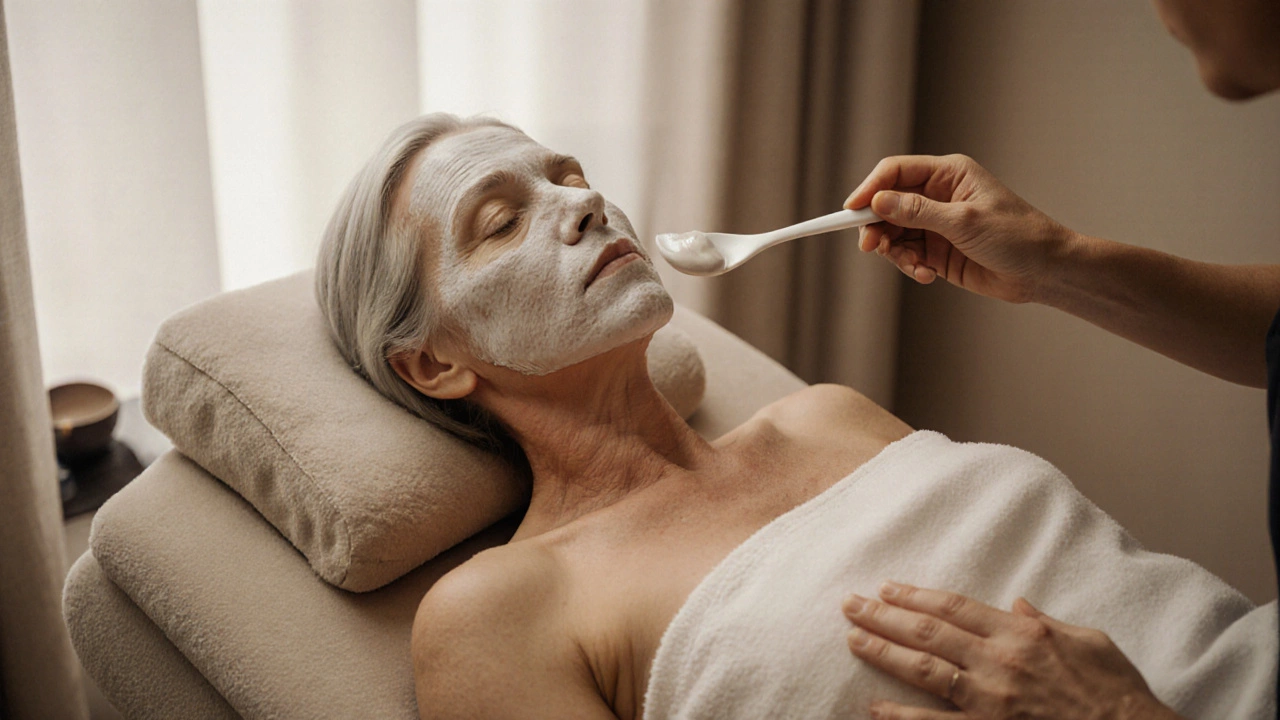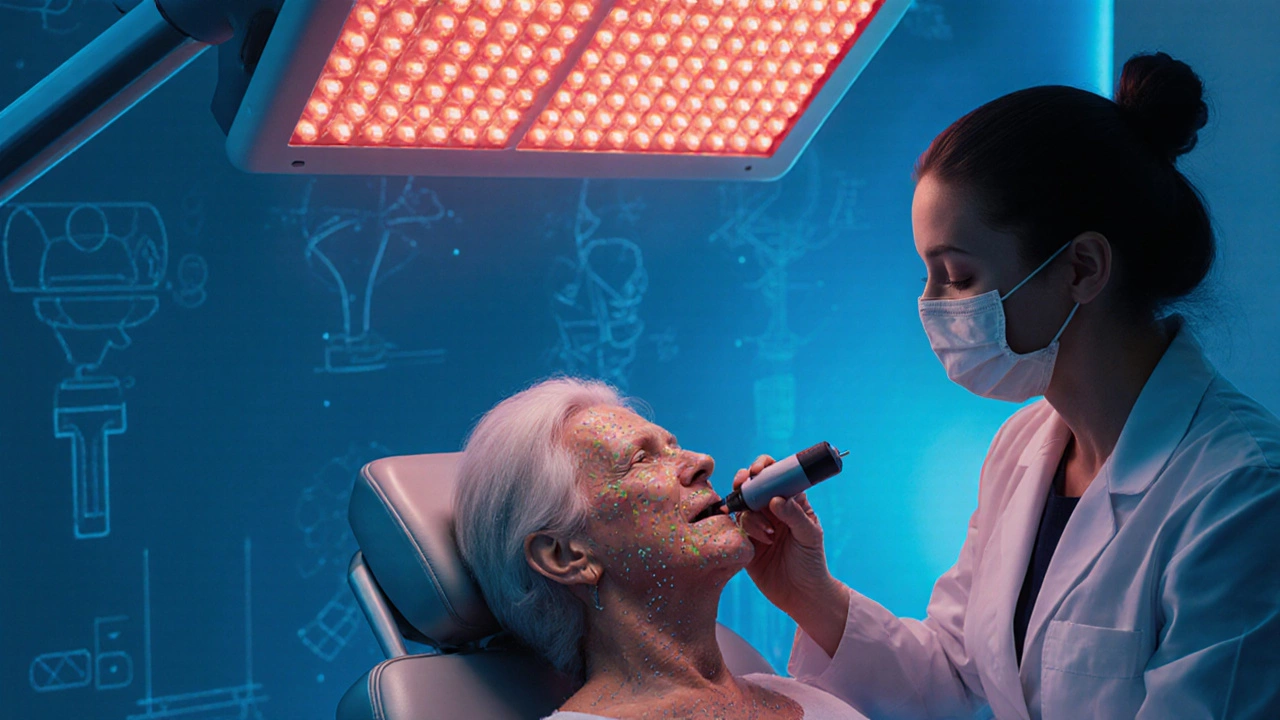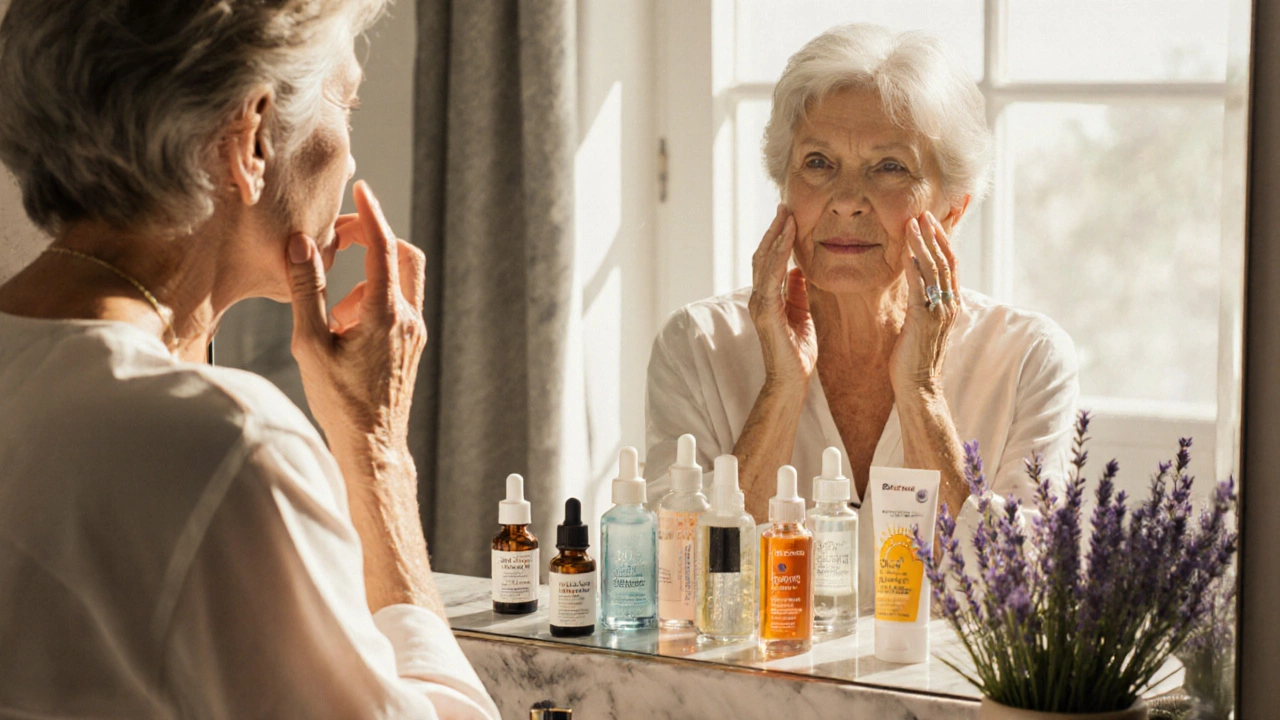Best Face Treatments for 60‑Year‑Old Skin: Expert Guide
 Oct, 19 2025
Oct, 19 2025
When it comes to mature skin, an anti‑aging facial is a specialized treatment designed to boost collagen, hydrate deeply, and smooth fine lines. At 60, the skin’s natural renewal slows, dryness spikes, and sun‑damage shows up as spots and laxity. The goal isn’t just a quick glow; it’s to support the skin’s structure, keep moisture locked in, and protect against further aging. Below is a step‑by‑step guide that mixes professional procedures, at‑home products, and daily habits so you can confidently pick the best face treatment for your age.
Understanding Mature Skin at 60
By the time you hit your 60s, the epidermal turnover rate drops to roughly half of what it was in your 20s. This means dead skin cells linger longer, making the complexion look dull. Elastic fibers (elastin) and the protein that gives skin its firmness (collagen) also decrease by about 1‑2% per year after age 30. The result is a thinner dermis, visible fine lines, and a tendency to lose moisture quickly.
Two factors dominate the aging picture:
- Intrinsic aging - the natural, genetic clock that slows cell renewal.
- Extrinsic aging - sun exposure, pollution, and lifestyle choices that accelerate damage.
Addressing both means choosing treatments that stimulate new collagen, restore barrier function, and shield the skin from UV rays.
Key Ingredients That Make a Difference
Modern skincare leans heavily on science‑backed actives. Below are the must‑haves for a 60‑year‑old’s regimen.
Retinol is a vitamin A derivative that speeds up cell turnover and encourages collagen synthesis. Clinical studies show 0.5%‑1% retinol can reduce wrinkle depth by up to 30% after 12 weeks. Start with a low concentration (0.25%) and apply at night to avoid sun sensitivity.
Hyaluronic acid acts like a sponge, holding up to 1,000 times its weight in water. For mature skin, a 1‑2% serum applied on damp skin can increase hydration by 45% within an hour, plumping the surface and softening fine lines.
Peptide complexes (e.g., Matrixyl, copper peptides) signal skin cells to produce more collagen. Unlike retinol, peptides are gentle enough for daily use and work well under sunscreen.
Vitamin C is an antioxidant that brightens hyperpigmentation and protects against free‑radical damage. A 10‑15% L‑ascorbic acid formula kept in an opaque bottle remains stable for up to 12 months.
Top Professional Treatments
If you’re comfortable visiting a clinic, these procedures offer the biggest payoff for mature skin.
Chemical peel - A medium‑strength glycolic or TCA peel removes the outermost skin layers, revealing smoother skin underneath. Typical downtime is 3‑5 days, and results include reduced age spots and finer surface texture.
Microneedling (also called collagen induction therapy) creates micro‑channels that trigger the body’s healing response. Studies show a 3‑month course can increase dermal thickness by up to 15%.
LED light therapy - Red LED (620‑750 nm) stimulates fibroblasts, while near‑infrared penetrates deeper to improve elasticity. Sessions are painless and require no recovery time, making it a popular add‑on for regular facials.
Microdermabrasion gently sands the skin’s surface, encouraging new cell growth. It’s less intense than a chemical peel, with just a few hours of redness afterward.
When booking, ask the practitioner about their experience with mature skin, the concentration of actives used, and whether they combine treatments (e.g., peel + LED) for synergistic effects.

At‑Home Routine for Best Results
Professional work can be complemented with a disciplined daily routine. Here’s a simple, evidence‑based schedule.
- Morning cleanse: Use a gentle, sulfate‑free cleanser to preserve the skin barrier.
- Antioxidant serum: Apply a 10% vitamin C serum on dry skin, then let it absorb for 2 minutes.
- Moisturizer with peptides: Choose a cream that lists peptides (e.g., Matrixyl) in the first three ingredients.
- Sunscreen - the non‑negotiable step. Opt for a broad‑spectrum SPF 50+ formula with zinc oxide or titanium dioxide for physical protection. Sunscreen prevents further collagen breakdown and keeps retinol from degrading.
- Evening routine: Cleanse, then apply a retinol product (start 2-3 nights a week). Follow with a hyaluronic acid serum and a richer night cream.
- Facial massage - using upward strokes and gentle pressure stimulates lymphatic drainage and improves circulation. Doing this for 3-5 minutes nightly can make the skin look more lifted.
Consistency is key. Visible improvement usually appears after 8‑12 weeks.
Choosing the Right Treatment: Decision Checklist
| Treatment | Main Benefit | Downtime | Typical Cost (NZD) | Frequency |
|---|---|---|---|---|
| Chemical Peel | Exfoliates dead cells, lightens spots | 3‑5 days redness | 150‑300 | Every 4‑6 weeks |
| Microneedling | Boosts collagen, improves texture | 1‑2 days mild swelling | 200‑400 | Every 6‑8 weeks |
| LED Light Therapy | Enhances elasticity, reduces inflammation | None | 100‑250 per session | 2‑3 times/week |
| Retinol Serum | Speeds cell turnover, smooths lines | None (possible irritation) | 30‑80 per bottle | Nightly (2‑3 times/week initially) |
| Hyaluronic Acid Serum | Deep hydration, plumps skin | None | 25‑70 per bottle | Daily |
Use this table to match your budget, tolerance for downtime, and how quickly you want results. For most 60‑year‑olds, a hybrid approach-professional microneedling every 2 months plus a nightly retinol routine-delivers the best balance of efficacy and safety.

Common Mistakes to Avoid
- Skipping sunscreen: Even on cloudy days, UV‑A penetrates and undermines every other effort.
- Over‑exfoliating: Combining a strong peel with daily retinol can irritate the barrier, leading to redness and breakouts.
- Choosing low‑quality actives: Cheap retinol often lacks stabilizers, causing oxidation and reduced benefits.
- Ignoring lifestyle factors: Smoking, excessive alcohol, and poor sleep accelerate aging just as much as skin‑deep factors.
- Expecting overnight miracles: Collagen remodeling takes weeks; patience yields lasting results.
Frequently Asked Questions
How often should a 60‑year‑old get a chemical peel?
Most dermatologists recommend a medium‑strength peel every 4‑6 weeks. This interval allows the skin to fully renew before the next treatment, minimizing risk of over‑peeling.
Is retinol safe for sensitive skin at my age?
Yes, if you start with a low concentration (0.25%‑0.3%) and apply every third night. Pair it with a soothing moisturizer and always follow with sunscreen.
Can LED light therapy replace professional procedures?
LED is a great maintenance tool, but it doesn’t stimulate collagen as aggressively as microneedling or peels. Use it as a complement rather than a full substitute.
What’s the biggest mistake beginners make with facial massage?
Using too much pressure. Gentle upward strokes with your fingertips or a silicone roller are enough to stimulate circulation without pulling the delicate skin.
Should I combine retinol with vitamin C?
It’s safer to use vitamin C in the morning and retinol at night. This separation reduces the chance of irritation while still delivering the antioxidant and anti‑aging benefits.
